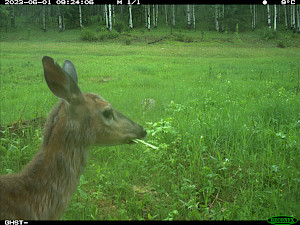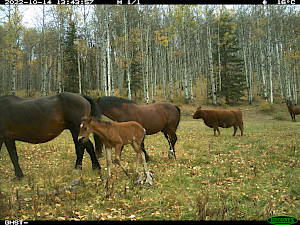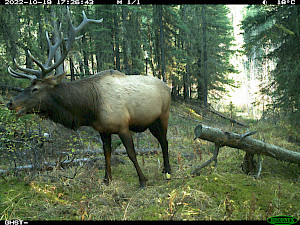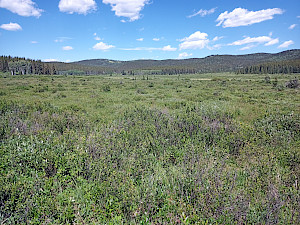Hello! My name is Sejer Meyhoff, I am a year into my Ph.D. at the University of Alberta in Dr. Erin Bayne’s lab. Most of the folks in the Bayne lab deal with bioacoustic data (sound recordings) collected in different habitats all over the province to monitor birds around different kinds of disturbances.
Photos by Apoorv Saini (left) and Bijaya Dhami (right) (University of Alberta - Bayne lab)
My project is no exception; I am sampling bird communities in Alberta’s beautiful foothills using Autonomous Recording Units (ARUs). Since my objectives also include evaluating the potential role of large herbivores in altering bird communities, I am also using remote cameras.
Sejer Meyhoff (University of Alberta - Bayne lab) - Linking herbivores to bird communities
Like many places, the foothills have been subject to wildfire suppression for many years. This disruption to the fire cycle has resulted in shrub encroachment on grasslands, which has reduced the amount of forage available for grazing animals like cattle, free-roaming horses, elk, and mule deer.




Sejer Meyhoff (University of Alberta - Bayne lab) - Linking herbivores to bird communities
As a result, there is a risk that the remaining grasslands will be overgrazed, which would change the plant communities and could result in loss of biodiversity. Birds are of course dependent on vegetation in its various forms, depending on their life history, for food, cover, and nesting habitat. In short, bird communities will change if the vegetation structure changes.
So, I predict that we will see measurable changes in bird communities in areas that see excessive shared use by large herbivores. This idea is related to the concept of ecological cascades (where changes in animal behaviour, like predator-prey interactions, within the food chain have far reaching effects down the food chain and on the entire ecosystem) and is similar to the classic example that occurred in Yellowstone National Park with the reintroduction of wolves. When wolves were reintroduced to Yellowstone they caused changes in the movement patterns of elk and thus also where elk were foraging. Elk acted as ecosystem engineers, and their change in foraging habits affected the entire ecosystem by altering vegetation structure in key habitats. I want to see if large herbivores in Alberta’s foothills can have a measurable effect on bird communities through their foraging habits and impact on vegetation structure. I am excited to continue this research and field work in the coming years and to explore what other insights we might glean from this growing dataset!
Written by Sejer Meyhoff, Ph.D. student in the Bayne Lab, University of Alberta (meyhoff@ualberta.ca). The project team includes Dr. Erin Bayne , Dr. Mark Boyce, Dr. Edward Bork (University of Alberta), the Bioacoustic Unit, Cassie Stevenson (Biodiversity Pathways) and Marcus Becker (Alberta Biodiversity Monitoring Institute), Innotech Alberta, West Fraser, the Forest Resource Improvement Association of Alberta, and the Government of Alberta.